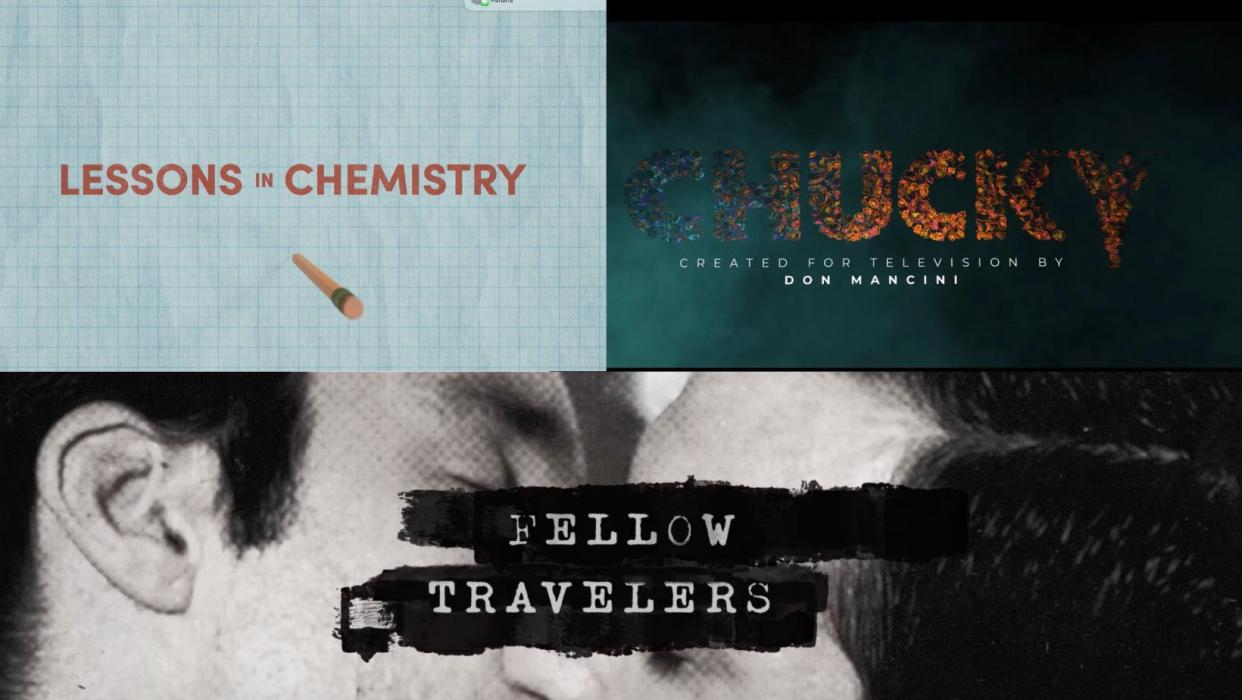Opening Credits Are Better Than Ever, So Stop Skipping Them

- Oops!Something went wrong.Please try again later.
- Oops!Something went wrong.Please try again later.
Opening credits never really went away (think of the slow-mo demolition of “The Good Fight”), but they are definitely having a moment.
“I really love title sequences,” “Chucky” showrunner Don Mancini told IndieWire. “ I lament the loss of titles. I just love the ritualistic value of them.”
More from IndieWire
When correctly deployed, opening credit sequences can do some heavy lifting for TV shows. The best title credit sequences set the tone for the show, hint at what’s to come, and, depending on when they’re used, underscore what just happened in the cold open. But in the wake of streaming upheavals and changes to how we consume content, they’ve been missing more and more. Or skipped more and more, depending on the options of a given platform.
But there are gifts to the sequences that compensate for shaving a minute or two off your watch time. For Prime Video’s “Wilderness” — a deliriously pulpy melodrama about a wronged wife seeking revenge on her cheating husband — the illustrated titles provide Easter eggs that reward viewers over the course of the series by revealing that the twists and turns were hidden in plain sight. “Chucky” takes a different route; each episode has a bespoke title sequence (courtesy of London-based Huge Designs) in which different images merge together to form the show’s title. (Interestingly, the “Chucky” font has never changed since the release of “Child’s Play” in 1988.)

In Season 3, the serial killer doll worms his way into the White House under the arm of the First Son, so of course, the season premiere’s main credit sequence finds “Chucky” spelled out in American flags. “I’ll pitch ideas for certain episodes,” Mancini said. “For Episode 1, I knew I wanted it to be American flags. That just seemed right. But they will come back with their own ideas. It’s a really fun process.”
“Fellow Travelers,” the Showtime limited series about a star-crossed gay romance over decades, uses its sequence to call attention to the LGBTQ history that was neglected for too long.
“Those two minutes represent months of work,” creator and showrunner Ron Nyswaner told IndieWire. A collage of vintage photos showing queer love, the sequence required hours of research and clearances to use the photographs from books like “Loving: A Photographic History of Men in Love 1850s-1950s.” With Paul Leonard-Morgan’s skittering, propulsive main title theme, the credits — from IAMSTATIC — achieve a balance between romance and fear. What we’re looking at is love; what we’re hearing is ominous. There’s no more succinct summation of the show’s tortured romance.
Apple TV+’s “Lessons in Chemistry,” meanwhile, turned to Elastic, the company behind the opening credits of everything from “American Horror Stories” to “The Morning Show.” Like the latter drama, “Lessons in Chemistry” wanted something non-literal but with a narrative.
As Mildred Bailey sings “Wham (Re-Bop-Boom-Bam),” a series of pencils meet, circle, and sketch out double helixes and then circle recipes on graph paper, a nod to Elizabeth Zott’s combined fascination with chemistry and its application to cooking.
“[We used] the pencil because it’s so integral,” said Elastic’s Rob Cawdery. “That and the notebook, Elizabeth is rarely without them throughout the series.” With that pencil representing Elizabeth, a complex choreographed dance ensues between it and pencils representing the other characters, with plenty of Easter eggs for those who watch later episodes, including some rowers and paw prints representing Elizabeth’s beloved dog.
The early selection of Bailey’s song sharpened the sequence even further and allowed Elastic to synchronize the animation to the music and lyrics. But, as with the careful placement of the “Chucky” sequence, “Lessons in Chemistry” leaned into the multiple tones of its titles to underline a moment — never more powerfully than in Episode 2.
“We knew that the second episode was going to show her being sexually assaulted, and it’s like, ‘How are we going to have this bright, upbeat sequence when something that’s quite horrific is going to happen?” Elastic’s creative director Hazel Baird told IndieWire. “But the way they’ve edited it is It happens, and then she goes and talks to her professor. And then at the very end, she says, ‘You know what? I wish I had more pencils [to stab him with].’ And then the sequence comes on. So it kinda ties it brilliantly to something that was obviously quite dramatic.”
It’s a powerful edit that only highlights Elizabthe’s strength and resilience and a moment of catharsis as the pencils swoop in once again to the accompaniment of Bailey’s tough vocals. Mancini and “Chucky” also try to utilize the credits for maximum effect. “Even beyond the bespoke sequence that we have for each episode, we work hard to place the titles interestingly,” Mancini said. “Whenever possible, we try to put an actor’s name over their own face. We generally center the director’s credits, whereas everyone else is either left or right, just to make it a little special. We give a lot of thought to that stuff.”
So the next time the “skip intro” prompt pops up, put down the remote, sit back, and enjoy the extra credit these shows went for.
Best of IndieWire
The Best Thrillers Streaming on Netflix in November, from 'Fair Play' to 'Emily the Criminal'
Sofia Coppola Movies, Ranked: 'Priscilla,' 'The Virgin Suicides,' 'Marie Antoinette,' and More
Sign up for Indiewire's Newsletter. For the latest news, follow us on Facebook, Twitter, and Instagram.

